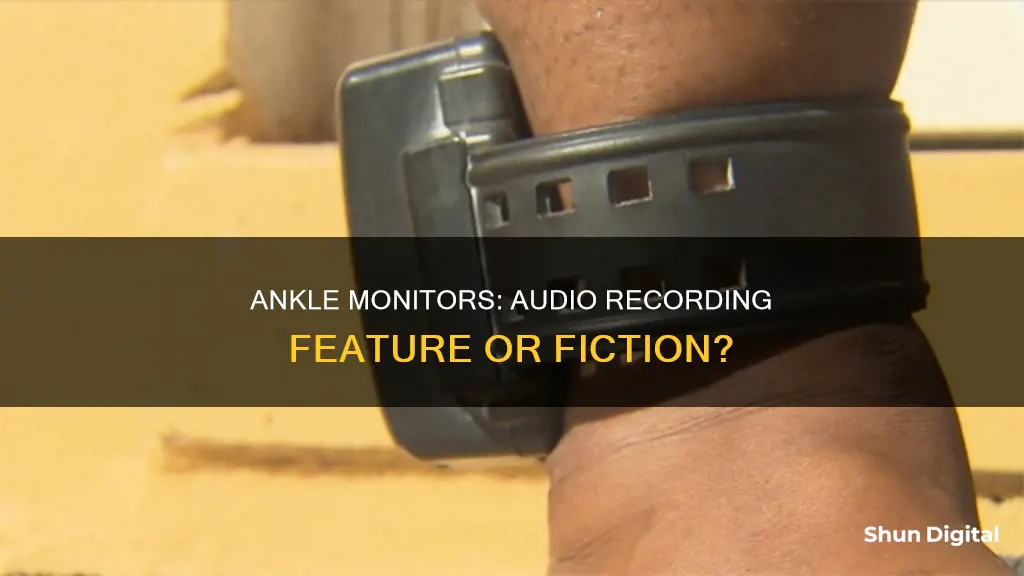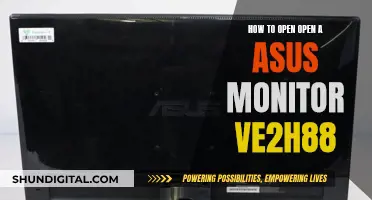
Ankle monitors are electronic devices fitted to individuals who are on probation, parole, or house arrest. They are also used to track undocumented immigrants and monitor alcohol consumption in repeat offenders of drinking-related crimes. While the primary purpose of these devices is to track the wearer's location via GPS, there has been an ongoing debate about whether they should also be allowed to record audio. This is because newer models of ankle monitors have been found to have built-in microphones that can be used for calling and recording people without their consent.
| Characteristics | Values |
|---|---|
| Do ankle monitors record audio? | Some ankle monitors have microphones and can record audio without consent. |
| Can the audio recording feature be activated without warning? | Yes, a technician testified in a case in Puerto Rico that the audio recording feature can be turned on without warning. |
| Who listens to the audio recordings? | It's usually either the monitoring service or the probation officer who listens to the audio recordings. |
| Who uses ankle monitors? | Ankle monitors are used by people on probation, awaiting trial, under house arrest, on parole, performing community service requirements, or for any other reasons a court feels it is appropriate. |
What You'll Learn

Ankle monitors may have microphones
Ankle monitors are electronic devices fitted to individuals that are used as an alternative to serving time in prison or jail. They are often worn by defendants who have been sentenced to house arrest or those on parole or probation. The devices work by transmitting the location of the wearer via GPS, allowing law enforcement to track their movements and ensure they are complying with court orders.
While not all ankle monitors have built-in microphones, some newer models do include this feature. The primary reason for including a microphone is to allow probation officers and law enforcement officials to identify the wearer from a remote location. The microphone and speaker are activated remotely, and the device will emit a sound or vibrate to indicate that a recording is about to begin.
The inclusion of microphones in ankle monitors has raised concerns about potential privacy violations and the infringement of defendants' rights. Critics argue that the recording capability of these devices could be a ""constitutional challenge" and that consent is an important issue, even when individuals consent to wearing the monitor.
Despite these concerns, there have been no reported cases of the state abusing the microphone feature in ankle monitors. The specific capabilities of an ankle monitor will depend on the model and the company that manufactures it.
Simple Ways to Check If Your Monitor Runs in HD
You may want to see also

Ankle monitors can record audio without consent
Ankle monitors are electronic devices fitted to individuals to track their location via GPS. They are often used as an alternative to prison or jail time, with judges ordering suspects to wear them while under house arrest, awaiting court appearances, or on parole or probation. While the primary purpose of these devices is location tracking, there have been concerns about their potential to infringe on privacy and civil liberties.
In recent years, the advancement of technology has led to the development of more sophisticated GPS ankle monitors that include built-in microphones. These microphones can be remotely activated, allowing for the recording of audio without the wearer's consent. While not all ankle monitors have this capability, the presence of microphones in some devices has raised concerns among legal experts and sparked debates about the ethical implications of such surveillance measures.
The inclusion of microphones in ankle monitors is particularly controversial because it has the potential to violate the wearer's privacy and civil rights. Critics argue that the ability to record audio without consent goes beyond the intended purpose of monitoring an individual's location. Additionally, there are concerns that the microphones could be activated without warning, potentially recording private or privileged conversations. This raises serious ethical and legal questions about the balance between public safety and individual privacy.
While proponents of audio-capable ankle monitors argue that they serve as an effective surveillance tool, opponents raise valid concerns about the potential for abuse and the invasion of privacy. The activation of microphones without warning, as revealed in a 2014 case in Puerto Rico, underscores the need for strict regulations and oversight to prevent misuse. Furthermore, the issue of consent is crucial, as individuals who are accused or convicted of crimes may feel coerced into agreeing to wear such devices, potentially compromising their rights.
In conclusion, while ankle monitors can provide a viable alternative to incarceration, the inclusion of audio recording capabilities without consent raises significant ethical and legal concerns. The potential for privacy invasions and the possibility of recording privileged conversations highlight the need for careful consideration and regulation of this technology. Striking a balance between public safety and individual liberties is essential to ensure that the use of ankle monitors does not result in unnecessary infringements on civil rights.
Televisions as Monitors: Easy Setup Guide for Beginners
You may want to see also

Ankle monitors can call people
Ankle monitors are electronic devices fitted to individuals to track their location via GPS. They are commonly worn by defendants who have been sentenced to house arrest or those on parole or probation.
While ankle monitors do not have microphones, some newer models do have the ability to call and record people. The ReliAlert XC3, for example, is a GPS ankle monitor made by a company called the Track Group that can call and record people wearing the device. The monitor is supposed to play a three-note sound when an official calls and a recording begins. However, a technician testified in a 2014 case that the listening and speaking capabilities can be turned on without warning.
There are concerns about the privacy implications of ankle monitors with calling and recording capabilities. While individuals who wear the devices are supposed to provide consent for the use of a device that can record conversations, critics argue that this does not adequately protect privacy. For example, someone wearing an ankle monitor should be able to expect privacy in certain situations, such as when using the bathroom. Additionally, individuals who are not being monitored but interact with the person wearing the device also have a right to privacy and should not be recorded without their consent.
Despite these concerns, there have been no reported cases of the state abusing the microphone feature of ankle monitors.
Hilton's Internet Monitoring: What You Need to Know
You may want to see also

Ankle monitors can be used to enforce probation
Ankle monitors are a form of surveillance used to track the location of an individual. They are often used as an alternative to prison or jail time, with judges ordering their use during probation or for pre-trial conditions that allow the defendant to be released with local restrictions or house confinement. Ankle monitors are also used to enforce bail or probation conditions, as well as in immigration contexts and to monitor alcohol consumption for repeat offenders of drinking-related crimes.
The use of ankle monitors has been on the rise, with a 140% increase in court-ordered GPS ankle bracelet monitors in the US between 2005 and 2015. This increase can be attributed to the need to slow the spread of COVID-19 in prisons and jails, as well as the growing trend of decarceration and the use of alternative forms of punishment and surveillance.
Ankle monitors work by transmitting the location of the wearer via GPS or radio frequency technology. This allows law enforcement to track the individual and ensure they are complying with court orders, such as house arrest or parole restrictions. If the wearer attempts to remove the bracelet or moves beyond a permitted area, an alarm is triggered and the police are dispatched to their last known location.
While ankle monitors do not currently have microphones, newer models have the ability to call and record people. This has raised concerns about privacy and the potential for abuse of this technology. However, it is important to note that there have been no reported cases of the state abusing the microphone feature.
The effectiveness of ankle monitors as a form of surveillance and punishment is debated. On the one hand, they allow individuals to continue with their lives and prepare for potential prison terms. On the other hand, critics argue that there are issues with the accuracy of the data collected, the lack of secondary checks, and the ownership and access rights to the data. Additionally, the use of ankle monitors can be financially burdensome for the wearer, with fees ranging from $3 to $35 per day, excluding initial setup charges.
Monitoring Bandwidth Usage: Top Programs to Watch Your Network
You may want to see also

Ankle monitors can be used to monitor alcohol consumption
Ankle monitors are electronic devices fitted to individuals to track their location and movement. They are often used as an alternative to prison or jail time, with judges ordering their use during probation or for pre-trial conditions. Ankle monitors are also used to enforce local restrictions, in-home confinement, and house arrest.
Ankle monitors do not currently have microphones, but newer models can call and record people. They are not used to eavesdrop on conversations, but they can be used to identify the wearer through voice recognition.
Ankle monitors can also be used to monitor alcohol consumption for repeat offenders of drinking-related crimes, such as DUIs. These devices can measure blood alcohol content in two ways:
- Through the skin: The SCRAM CAM bracelet, for example, automatically samples the wearer's perspiration every 30 minutes to detect the presence of alcohol.
- Remote breathalyser testing: Ankle monitors can also be used to conduct breathalyser tests, similar to a breathalyser test administered by a law enforcement officer.
The use of ankle monitors to monitor alcohol consumption provides accountability and encourages compliance with court orders. It also supports long-term behaviour change and complements treatment for alcohol dependence or addiction.
Easy Holter Monitor Setup: 5-Lead Connection Guide
You may want to see also
Frequently asked questions
Ankle monitors, also known as ankle bracelets or tags, are electronic devices fitted to individuals that transmit their location via GPS. Some newer models of ankle monitors have microphones and can record audio without consent.
Ankle monitors are used as an alternative to prison or jail. They are commonly worn by defendants who have been sentenced to house arrest or those on parole or probation.
Ankle monitors work by transmitting the location of the wearer via GPS. This allows law enforcement to track the wearer and ensure they are complying with court orders. If the wearer attempts to remove the bracelet, an alarm is triggered and the police are dispatched to their last known location.
The data collected by ankle monitors is typically owned by the law enforcement agency monitoring the individual. However, other federal and state-level departments, as well as third-party companies, may also have access to the data.
Yes, ankle monitors can also be used to monitor alcohol consumption for repeat offenders of drinking-related crimes. These devices can measure blood alcohol content through the skin or provide remote breathalyzer testing.







